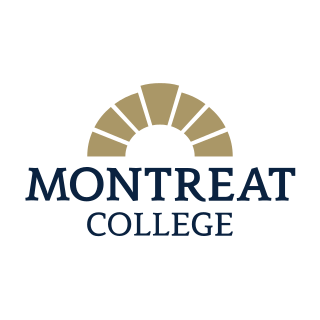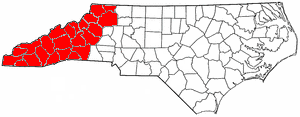Related Research Articles

Presbyterianism is a part of the Reformed (Calvinist) tradition within Protestantism that broke from the Roman Catholic Church. Presbyterian churches derive their name from the presbyterian form of church government by representative assemblies of elders. Many Reformed churches are organised this way, but the word Presbyterian, when capitalized, is often applied to churches that trace their roots to the Church of Scotland or to English Dissenter groups that formed during the English Civil War.

Cherryville is a city in northwestern Gaston County, North Carolina, United States. The population was 5,760 at the 2010 census. The New Year's Shooters celebrate the area's German heritage by beginning each year with a customary chant and the honorary shooting of muskets. Cherryville is located approximately 38 miles (61 km) west of Charlotte and 16 miles (26 km) northwest of Gastonia.

Roan Mountain is a census-designated place (CDP) in Carter County, Tennessee, United States. The population was 1,360 at the 2010 census. It is part of the Johnson City Metropolitan Statistical Area, which is a component of the Johnson City–Kingsport–Bristol, TN-VA Combined Statistical Area – commonly known as the Tri-Cities region.

Thomas Lanier Clingman, known as the "Prince of Politicians," was a Democratic member of the United States House of Representatives from 1843 to 1845 and from 1847 to 1858, and U.S. senator from the state of North Carolina between 1858 and 1861. During the Civil War he refused to resign his Senate seat and was one of ten senators expelled from the Senate in absentia. He then served as a general in the Confederate States Army.

Union Presbyterian Seminary is a Presbyterian seminary in Richmond, Virginia, and Charlotte, North Carolina, offering graduate theological education in multiple modalities: in-person, hybrid, and online.

Thomas Ustick Walter was an American architect of German descent, the dean of American architecture between the 1820 death of Benjamin Latrobe and the emergence of H.H. Richardson in the 1870s. He was the fourth Architect of the Capitol and responsible for adding the north (Senate) and south (House) wings and the central dome that is predominantly the current appearance of the U.S. Capitol building. Walter was one of the founders and second president of the American Institute of Architects. In 1839, he was elected as a member to the American Philosophical Society.

Christians in Bangladesh account for 0.30% of the nation's population as of 2022 census. Together with Judaism and Buddhism, they account for 1% of the population. Islam accounts for 91.04% of the country's religion, followed by Hinduism at 7.95% as per 2022 census.

Montreat College is a private, Christian college in Montreat, North Carolina. Founded in 1916, the college offers associate, bachelor's, and master's degree programs for traditional and adult students. The college's main campus for four-year traditional students is located in the foothills of the Blue Ridge Mountains outside of Asheville, North Carolina.

William Peace University is a private college in Raleigh, North Carolina. Formerly affiliated with the Presbyterian Church, it offers undergraduate degrees in more than 30 majors and the School of Professional Studies (SPS) offers accelerated bachelor degrees that are online or hybrid for working adults. The institution adopted its current name in 2012, concurrent with its decision to begin admitting men to its day program; it was previously known as Peace Institute, Peace Junior College, and Peace College.
Rev. John Brown was the third president of the University of Georgia. He served in that capacity from 1811 until his resignation in 1816.

Western North Carolina is the region of North Carolina which includes the Appalachian Mountains; it is often known geographically as the state's Mountain Region. It contains the highest mountains in the Eastern United States, with 125 peaks rising to over 5,000 feet in elevation. Mount Mitchell at 6,684 feet, is the highest peak of the Appalachian Mountains and mainland eastern North America. The population of the region, as measured by the 2010 U.S. Census, is 1,473,241, which is approximately 15% of North Carolina's total population.

North Carolina's 11th congressional district encompasses most of Western North Carolina. Since January 3, 2023, the district has been represented by Chuck Edwards.
Zionville in an unincorporated community located in Watauga County, North Carolina. The community lies at the North Carolina/Tennessee state line, between Boone and Mountain City, along Old US Highway 421.
Presbyterian Mission Agency is the ministry and mission agency of the Presbyterian Church (U.S.A.). Founded as the Western Foreign Missionary Society by the Presbyterian Church in the United States of America in 1837, it was involved in sending workers to countries such as China during the late Qing dynasty and to India in the nineteenth century. Also known as the Foreign Missions Board in China, its name was changed by the Old School body during the Old School–New School Controversy to the Presbyterian Board of Foreign Missions.
The Presbyterian Church of India (PCI) is a mainline Protestant church based in India, with over one and a half million adherents, mostly in Northeast India. It is one of the largest Christian denominations in that region.

David Purviance, November 14, 1766 – August 19, 1847, was a member of the Kentucky legislature, a member of the Ohio legislature, and an important early leader in the Stone-Campbell Restoration Movement. He was also an early trustee (1819–1836) of Miami University in Oxford, Ohio, and often served as its president pro tempore.
Big Butt Mountain or Big Butt are the names of five distinct mountains in Western North Carolina. Butt in this context is a corruption of butte.
The American Home Missionary Society was a Protestant missionary society in the United States founded in 1826. It was founded as a merger of the United Domestic Missionary Society with state missionary societies from New England. The society was formed by members of the Presbyterian, Congregational, Associate Reformed, and Dutch Reformed churches with the objective "to assist congregations that are unable to support the gospel ministry, and to send the gospel to the destitute within the United States." In 1893, the Society became exclusively associated with the National Council of Congregational Churches and was renamed the Congregational Home Missionary Society.

References
- 1 2 U.S. Geological Survey Geographic Names Information System: Higgins, North Carolina
- ↑ "Higgins (in Yancey County, NC)", North Carolina Home Town Locator, retrieved April 28, 2017.
- ↑ Elaine McAlister Dellinger and Kiesa Kay, Yancey County, Images of America, Charleston, South Carolina: Arcadia, 2011, ISBN 9780738587608, p. 2.
- 1 2 Robert Kanigel, Eyes on the Street: The Life of Jane Jacobs, New York: Knopf, 2016, ISBN 9780307961907, p. 54].
- 1 2 "Higgins", William S. Powell and Michael Hill, The North Carolina Gazetteer: A Dictionary of Tar Heel Places and Their History, 2nd ed. Chapel Hill, North Carolina: University of North Carolina, 2010, ISBN 9780807833995, p. 241.
- ↑ Kanigel, pp. 55–57.
- ↑ "History Association Meeting", Estatoee, XIII.2, Yancey History Association, May 1998, p. 1.
- 1 2 Carolyn Sakowski, Touring the Western North Carolina Backroads, Touring the Backroads Series, 3rd ed. Winston-Salem, North Carolina: John F. Blair, 2011, ISBN 9780895875594, p. 181.
- ↑ Kanigel, pp. 55, 58.
- ↑ Jane Jacobs, Cities and the Wealth of Nations: Principles of Economic Life, New York: Random House, 1984, ISBN 9780394480473, pp. 124–29.
- ↑ Vital Little Plans: The Short Works of Jane Jacobs, ed. Samuel Zipp and Nathan Storring, Toronto: Vintage Canada, 2017, ISBN 9780345812018, n.p.
- ↑ Peter L. Laurence, Becoming Jane Jacobs, The Arts and Intellectual Life in Modern America, Philadelphia: University of Pennsylvania, 2016, ISBN 9780812247886, p. 20.